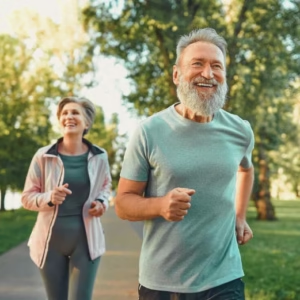
Why is it important for older people to work out?
Increasing your heart rate and giving your muscles something to work on is beneficial for your body in many ways and can help your mental and physical health. Being active helps keep your blood pressure in a healthy range, stops dangerous plaque from building up in your arteries, lowers inflammation, raises blood sugar levels, makes bones stronger, and keeps you from getting depressed. A daily exercise plan can also improve your sex life, help you sleep better, lower your risk of some cancers, and even make you live longer.
They don’t know what kinds of safe and effective exercise to do or how much exercise they need to do, which makes a lot of older people hesitant to get moving. Any movement is better than doing nothing, so there’s no harm in starting easy and gradually adding longer workouts. For at least 150 minutes a week, you should be active at a modest level. If you can’t start there, make your way up (and past it). As an adult, there are many ways to stay fit and exercise, but you should also stay busy during the day by doing things like walking, yard work, and playing with your grandchildren.
Most seniors can begin exercising without consulting a doctor, but some should. To make sure you don’t hurt your health, you should talk to your doctor first if you have diabetes, high blood pressure, heart or lung disease, osteoporosis, or a brain disease. People who have trouble moving around because of things like pain or inadequate balance should also talk to their doctor.“Transform Your Health After 40: Benefits of Power Yoga for Strength, Flexibility, and Wellness”

What is the most effective workout?
There are a lot of different kinds of exercise, but experts have divided them into four main groups based on what they do to your body and how they help you.
A faster heart rate marks aerobic exercise. Even though you move your whole body during aerobic activities, the main focus is on your heart and lungs. This is the reason people often refer to aerobic exercise as “cardio”: it strengthens and enhances your cardiovascular system. If you do things like walking, swimming, dancing, and riding hard enough, they will make your heart work harder and your breathing faster. When you do aerobic workouts, you burn fat, boost your mood, lower your blood sugar, and reduce inflammation.
Two to three times a week, you should do strength training, which is also sometimes called resistance exercise. Exercises like squats, lunges, push-ups, and those done on resistance machines with weights or bands can help keep muscle mass and power up or even build it. Strength training can also help you avoid falling, keep your bones healthy, lower your blood sugar, and make your balance better. Do movements that are both isometric and isotonic. When performing isometric movements such as planks and holding leg lifts, your body remains stationary. They are excellent for staying strong and making you more stable. When you do isotonic movements, you have to hold your weight throughout a range of motion. Isotonic exercises include sit-ups, bicep curls, and bench pushes.
As you get older, stretching routines can help keep your muscles and tendons flexible, keep your posture straight, and make it easier to move around. It’s okay to stretch every day.Shoshin Mindset Lead To Improvements In Your Mental & Physical Health.
Different parts of your body, like your inner ear, vision, muscles, and joints, work together during balance tasks to help you stay upright and oriented. Yoga and Tai Chi are excellent ways to improve your balance and keep you from falling as you get older.

How often should I work out?
How much exercise you should do depends on a number of things, such as your existing fitness level, your fitness goals, the types of exercise you want to do, and whether you need to work on your strength, flexibility, or balance.
As a general rule, you should do at least 150 minutes of moderately intense aerobic action (or 75 minutes of vigorous exercise) each week. As your fitness improves, you should strive to exceed this minimum requirement to maximize the benefits. If you want to naturally break up the 150 minutes, you could do a 30-minute session five times a week. You could also do two 15-minute lessons in one day. Follow whichever plan works best for you.
As a general rule, you should work out all of your major muscle groups twice or three times a week, giving your body 48 hours to heal between events. That’s two workouts a week if you do “total-body” workouts. If you choose to split your workouts up to focus on a certain muscle group (like “leg day”), you will need to work out more often. Just make sure you let a big muscle rest for 48 hours before working it again.
For those who have noticed issues with their balance, like feeling unsteady, dizzy, or having vertigo, talk to a doctor or nurse about activities that can help. Along with three 30-minute workouts a week, go for a 30-minute walk at least twice a week.
A few minutes of warming up are the best time to stretch. You can also do stretching routines after your workout. Slowly and steadily stretch each muscle group, let go, and do it again.
But what is the threshold for excessive exercise? You should expect your muscles to hurt a little after working out, especially at first. But if your body doesn’t seem to heal between workouts, you might be training too much. Keep in mind that older people need more time to heal than younger people. Your workout plan should make you feel good, unless your muscles hurt, which is “welcome.” If it doesn’t, you’re probably doing too much. You shouldn’t stop working out, but you should lower the speed or number of times you do them until you find the “sweet spot” where your body is “tired out” but has recovered enough to go into your next session with energy.Effective Weight Management Strategies for Men Over 40

Why is exercise beneficial for you?
A well-thought-out exercise plan will help your body and mind in a huge number of ways.
A lot of research has shown that exercise is beneficial for your mental health. One large study, for instance, found that people who don’t move around much are 44% more likely to be sad. Another study found that people with mild to moderate depression could get the same benefits from exercise as from drugs if they did it for 90 minutes a week. Brain chemicals like serotonin and dopamine, which help improve happiness and fight stress, seem to be the key.
Exercise can help your heart health, which is something we all know. You might ask, How does exercise drop blood pressure? In an intriguing twist, aerobic exercise raises your blood pressure briefly by making your circulatory system work harder. But once you stop exercising, your blood pressure drops back to where it was before you started.
A lot of people think that exercise is an important part of losing weight. They’re not wrong, even though food is also very important. But what kind of exercise melts away the most fat? Aerobic workouts, like cardio, are a beneficial way to burn calories and lose fat. But don’t forget how useful strength training is. This is the best way to strengthen bones and increase lean muscle to fat ratio. There isn’t a single “Holy Grail” exercise that will help you lose weight. The best way to lose weight is to do a workout that you will keep up with. The best exercise for weight loss is the one that gets your heart rate up and your body moving while you have fun and stay inspired.Understanding Life Coaching: Transforming Your Life with the Help of a Life Coach

What happens if I am unable to engage in extensive physical activity?
No matter how hard, everyone should exercise. For seniors, experts have come up with workouts that are safe, low-impact, and can be done while sitting down if needed.
People over 65 can do balance exercises while hanging on to a chair or doorframe if they are worried about falling. Keep your abs tight and lift one leg to the same height as the other leg’s knee while holding the back of a chair. You could start with one hand on the chair and release it as you improve.
People with limited abilities can adapt even core-strengthening activities for seniors to meet their needs. As an example, to do a standard plank, stand with your back straight and only your forearms and toes hitting the mat. You can also put your knees on the mat for an easier option. However, you can make the plank even easier by standing up and leaning forward. Your back is straight and your elbows and wrists are on a desk, table, or wall. You rest on the balls of your feet.
There are different kinds of stretching movements for seniors, so everyone can find one that works for them. For a full-body stretch, lie on your back, straighten your legs, and reach your hands along the floor past your head. If you can’t hold movements on your hands and knees, you could try this one instead. You can perform certain stretches, such as neck twists and head stretches, while seated.
In fact, you can do other kinds of exercise while sitting down as well. Seniors can also do bicep curls (with dumbbells or elastic bands), overhead dumbbell presses, shoulder blade squeezes, calf raises, sit-to-stands (chair squats), and knee extensions while sitting in a chair.How To Do Weight Management Strategies for Women Over 40

In terms of movement, what is best for heart health?
The best way to strengthen your entire body, increase your endurance, and safeguard your health over time is to incorporate both aerobic and strength training into your workout routine. To improve your cardiovascular health, focus on activities that work your heart and lungs harder and send oxygen to your cells. Strength training is beneficial for your heart, but cardio workouts are better for lowering blood pressure, keeping the inner walls of your arteries healthy, releasing enzymes that break down blood clots, and even encouraging the growth of new arteries that feed the heart.
A lot less people get type 2 diabetes if they do physical exercise regularly. People don’t usually think of diabetes as a heart problem, but having less diabetes also lowers your chance of heart disease. This is because high blood sugar hurts blood vessels and the nerves that control the heart. When you work out, you tell your cells to remove glucose (sugar) from your blood. They do this by becoming more sensitive to insulin, a hormone that is important for glucose metabolism. In other words, your cells will still respond to insulin long after you stop working out. Diabetes is more likely to happen if you are overweight, so movements that help you lose fat, especially around your middle, will help you avoid getting diabetes.“How to Use the Power of Color Prana to Elevate Your Pranic Healing Skills”
RELATED POSTS
View all


